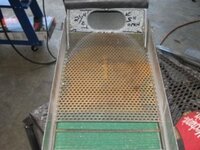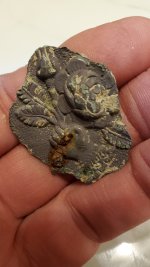I am seeking suggestions for recovering fine gold using a dredge. This dredge is not in a river bed, but on private property in the Motherlode outside of Jamestown. We have ground with shallow bedrock and the gold is definitely there and am getting color during clean up. However I am certain we are blowing a lot through the 3 inch keene combo. The prop owner is convinced faster is better, but from what I have read and what I am seeing slower is better and am still trying to put together recovery that will get everything possible.
We fill the dredging hole with water on first day and run it through Keene 3 inch as mentioned above and running the motor wide open. Second day, we take the sluice box out of the trommel and place it to catch discharge of 3 inch Keene. The second sluice is 18 inches wide with a very big mesh (pic tomorrow) and riffles and is 8 feet long. Pleasantly surprised with this approach as the material spread out very nicely. lots of black sand. At the end of large sluice I set up a settling pond with some material (think of it as coffee filter slightly thicker) 5 feet wide and 7 feet long and ran the water coming out of large sluice over it to see what we were missing. The water would "pond up" over the filter material and leech into another small water collection area. So we start up and do a good run of a lot of material and shut down. Lots of black sand in primary sluice (3 inch keene combo) and lots in big sluice. Bad thing lots of black sand in filtered settling pond which tells me we are not catching as much as we should in the primary sluices.
The material is rug in the Keene combo. The rug in the big sluice is something like, well, a bunch of plastic linguine that was used as a floor mat in a tire store. No kidding, still had the logo on it. So I will say without any reservations that I will eventually get this situation to work, but am hoping that someone will get me going down the right road for this situation as I am relying on trial and error. Again, more pics on Wed or Thur.
Thanks for your support!
We fill the dredging hole with water on first day and run it through Keene 3 inch as mentioned above and running the motor wide open. Second day, we take the sluice box out of the trommel and place it to catch discharge of 3 inch Keene. The second sluice is 18 inches wide with a very big mesh (pic tomorrow) and riffles and is 8 feet long. Pleasantly surprised with this approach as the material spread out very nicely. lots of black sand. At the end of large sluice I set up a settling pond with some material (think of it as coffee filter slightly thicker) 5 feet wide and 7 feet long and ran the water coming out of large sluice over it to see what we were missing. The water would "pond up" over the filter material and leech into another small water collection area. So we start up and do a good run of a lot of material and shut down. Lots of black sand in primary sluice (3 inch keene combo) and lots in big sluice. Bad thing lots of black sand in filtered settling pond which tells me we are not catching as much as we should in the primary sluices.
The material is rug in the Keene combo. The rug in the big sluice is something like, well, a bunch of plastic linguine that was used as a floor mat in a tire store. No kidding, still had the logo on it. So I will say without any reservations that I will eventually get this situation to work, but am hoping that someone will get me going down the right road for this situation as I am relying on trial and error. Again, more pics on Wed or Thur.
Thanks for your support!



 how much material do you think to process in one pass (in yards).
how much material do you think to process in one pass (in yards).



